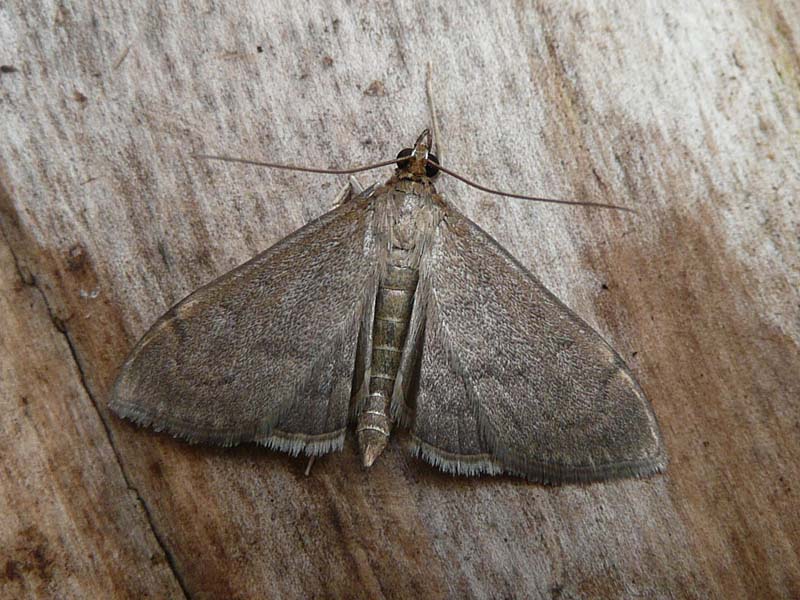Anania terrealis
Anania terrealis
Anania terrealis ( syn. Algedonia terrealis ) is a (small) butterfly of the family Crambidae.
Features
The wingspan of the moth is about 24 to 28 mm (or the forewing length 11 to 13 mm). Head and thorax are brown gray. The ground color of the wings varies only slightly from light brown, red-brown to brown -gray. The Saumfeld is often significantly darker in bright copies. Almost always the hem line or a slightly extended range within the seam line is drawn darker than the ground color. The forewing has two, often indistinct darker transverse lines drawn. The outer strongly jagged transverse line is centered strongly bulged outwards and jumps on the wing inner edge (or back) more sharply than in Kostal's edge. The often still fainter inner transverse line, however, is only slightly curved. Between the two lines cross is located close to the costal margin a cross- wire line. Often the outer transverse line is also partially or patchily lined bright. The apex of the forewing is pointed. The hindwing has only a jagged transverse line, but can also be very indistinct in some specimens. As with the front wing also here the Saumfeld is sometimes darker than the ground color. Remarkable are the much lighter, often whitish fringe.
The caterpillar is colored variable, the color palette ranges from yellowish white to bluish green and rose. It has a proportionate small, light yellowish brown head. This points to something darker, usually brown to dark brown spots. The wide back stiffeners and the thin side stripes are darker than the ground color. Younger caterpillars are quite slim, while older caterpillars are somewhat stocky.
The doll is relatively long ( 9.0 to 10.5 x 2.4-2.7 mm), slender and reddish brown in color. The medium length cremaster is little tapered at the end and blunt cut, flattened shape and dorsoventral in the plan. Lateral he shows at the base of each a dark longitudinal lined pit. It is equipped with medium long, hook-like bristles.
Geographical distribution and habitat
The species is widespread throughout central and northern Europe. It occurs locally in Southern Europe, on the Apennine peninsula to Sicily. But you missing on the Mediterranean islands of Corsica, Sardinia and Crete. Also from the rest of Greece it has not been established so far. In the British Isles the species occurs to the south of Scotland. In Scandinavia, the range extends to Finnish Lapland. In the east it extends across Siberia to the Russian Far East, China and Japan. It is also detected in Asia Minor and the Caucasus region. Final proof comes even from Ladakh ( Jammu and Kashmir, India). In contrast, a proof of the kind in Sichuan (China) has remained unconfirmed.
In Europe, the species prefers living on fresh sites such as Forest edges, clearings and backrest. In the Alps, it rises to 2000 m. The habitat of the species in Ladakh is situated at 3800 m altitude. In the Iberian Peninsula and North Africa, it is on a higher elevation from about 1350 m restricted ( detected up to 2350 m).
Way of life
Anania terrealis forms in climatically favorable regions of two overlapping generations per year, flying the moth from May to August. In England only one generation is apparently formed, the moths fly in June and July. The moths are active at dawn and come out at night to artificial light sources. They rest during the day in the vegetation, but can be easily startled. The caterpillars are found from July to May of the following year. They feed mainly from the ordinary goldenrod (Solidago virgaurea ), where the caterpillars preferably feed on leaves or the flowers. Hannemann also mentions mountain aster (Aster amellus ) and Alpenmaßliebchen ( Bellidiastrum mitchelii ) as a caterpillar food plant. They live here in a tubular web which they attach to the stem or the leaf underside of their food plants. They overwinter and pupate in this cocoon in May of the following year.
Systematics and Taxonomy
The taxon was described in 1829 by Georg Friedrich Treitschke under the binomials Botys terrealis first time scientifically. The holotype is from a further präzisierten locality in " Dalmatia ". The species is found in the literature in the combinations Mutuuraia terrealis, Eurrhypara ( Algedonia ) terrealis and Algedonia terrealis.
It is the type species of the genus Mutuuraia Munroe, 1976. Genera Mutuuraia Munroe, 1976 Eurrhypara Hübner, 1825 and Algedonia Lederer, 1863 today, in addition to numerous other genera as synonyms of the genus Anania Hübner, viewed 1823.
Speidel and Hanigk (1990 ) divide the species into two subspecies:
- Anania terrealis terrealis ( Treitschke, 1829), in the largest part of the range, with the exception of the Iberian Peninsula and North Africa and
- Anania terrealis reisseri ( Zerny, 1932), Iberian Peninsula and Xauen - Izilan, Rif Mountains, Morocco









